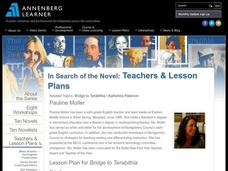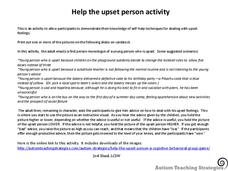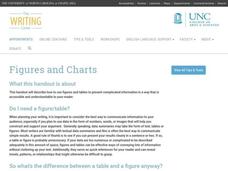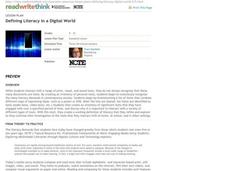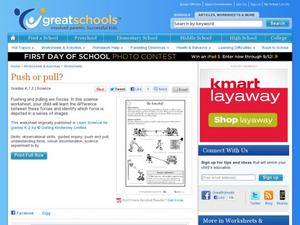American English
Welcome to the Color Vowel Chart
Focus English language learners' attention on word stress and phrase stress with a pronunciation chart that breaks the sounds into moving and non-moving vowel sounds. The chart tool uses colors and key words to indicate...
Curated OER
Words Can Hurt; Words Can Help
Help learners on the autism spectrum comprehend the social consequences of their actions by connecting kind and hurtful words to physical, tangible experiences. The worksheets in this resource prompt students to consider things they say...
Curated OER
Bridge to Terabithia
Students explore scenes from Katherine Paterson's book, Bridge to Terabithia. In this visualization lesson, students listen to the story read aloud. The students then choose words and phrases that paint a picture in their heads. Students...
Curated OER
Help the Upset Person Activity
Assess what self-help techniques your students know for dealing with upset emotions with this conversational activity. The teacher begins by role playing as an upset individual, using visual images as prompts, and then asks students...
University of North Carolina
Figures and Charts
Sometimes words aren't the best way to get information across to the reader. The eighth handout in the 24-part Writing the Paper series describes different type of figures and charts to display complex information in a paper....
ReadWriteThink
Defining Literacy in a Digital World
What skills are necessary to interact with different types of text? Twenty-first century learners live in a digital world and must develop a whole new set of skills to develop media literacy. Class members engage in a series of...
Curriculum Corner
Book Study: The Polar Express
All aboard! Pair a reading of The Polar Express by Chris Van Allsburg with a set of literacy activities. The packet of worksheets includes task cards, sorting activities, a synonym match, comparing and contrasting activities, writing...
Curated OER
Shapes- Extension Lessons for Young Gifted Learners
Students explore various shapes in the world around them. In this kindergarten art lesson plan, students read books, identify shapes by sides and corners, and draw shapes in sand, sugar, or flour. Extension activities are included.
Curated OER
Extending our Knowledge of Place Value
Students demonstrate their knowledge of place value through auditory, visual, and kinesthetic channels. In this place value lesson, kinesthetic learners work with a partner using both sets of hands to represent 2 digit numbers. Visual...
Curated OER
Center for Northwestern Art: Featured Objects
Each of the slides in this presentation provide learners with an image found at a northwestern art museum and a critical analysis of what can be seen in each piece. Learners can view this prior to a museum trip in order to build...
Curated OER
Crayon Crackle Painting
Explore crackle painting and Raku pottery with your little learners. They view examples of Raku pottery, discuss the crackle painting technique, and create an original image using crayons and glue. Sounds like an educationally fun time!
Concordia University Chicago
The Cradle by Berthe Morisot
The art activities found here have learners take a critical look at the role of women in the domestic setting. They analyze Berthe Morisot's The Cradle through a guided discussion. Then they paint men and women in traditional domestic...
Curated OER
Positions
A four question worksheet to teach, re-teach, or check for understanding of spatial relationships. Your young learners determine the position of the colored balls in relation to the box. They check off the answer that...
Curated OER
Find the Letters
Help beginning readers recognize that whole words are made up of individual letters. They examine a set of lowercase letters and circle the ones they find in a CVC word. Learners do this for the words bin and cup.
Curated OER
Matching the Shapes
Which of these blocks match? As they learn about shape attributes and the term same, scholars draw lines from block formations on the left to the same shapes on the right. The eight starting shapes are split into two sections to...
Curated OER
Match the Letters
Build a foundation of alphabet familiarity using this matching activity. Learners focus on lowercase letters a, o, c, d, g, and q as they match balloons to corresponding children. Each balloon and child has a letter inside, so...
Curated OER
Match the Letters
Before youngsters begin reading, they need a foundational familiarity with alphabet letters. This matching worksheet focuses on lowercase letters m, n, u, v, and w. Learners match letters on teddy bears with the same letter on hats by...
Curated OER
Be forceful!
Didn't some scientist develop rules about force and motion? Youngsters can experience physical science as they determine which picture shows the force of pushing or pulling. Tip: Ask learners if they can think of any unseen forces that...
Curated OER
Listening Picture Check Sheet & Listening Picture Prompts
Help learners build greater self-awareness and improve listening skills with these visual prompt sheets. Beginning with an "Are you really listening?" overview sheet, the following pages use large visuals to remind pupils...
Common Core Sheets
Comparing Visual Fractions
Introduce comparing fractions with a worksheet containing visual models. Young mathematicians must first identify the part being described in each model and then write greater than, less than, or equal to. Learners prepare to compare...
Curated OER
Family History Through Art
Students discuss various ways families and communities pass down oral and visual art forms to younger generations. This multi-subject introductory lesson prepares students to create a project about their own families.
Curated OER
Tennis Balls in a Can
Make your classroom interesting by teaching or assessing through tasks. Deepen the understanding of Geometry and motivate young mathematicians. The task uses investigation with tennis balls and their container to prompt learners to...
It's About Time
Who Eats Whom?
Packed with visual aids and multiple learning opportunities, an engaging exercise challenges individuals as they explore the role of producers, consumers, and decomposers. After discussing differences between food chains, food...
Weebly
Infographic Project
This multi-faceted, progressive project includes an array of activities for analyzing and evaluating a theme of American history. Learners begin by constructing a timeline of events in United States history using Google docs, create a...




